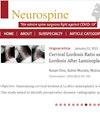Surgeon Preference Regarding Wound Dressing Management in Lumbar Fusion Surgery: An AO Spine Global Cross-Sectional Study
IF 3.8
2区 医学
Q1 CLINICAL NEUROLOGY
引用次数: 0
Abstract
Objective To evaluate the global practice pattern of wound dressing use after lumbar fusion for degenerative conditions. Methods A survey issued by AO Spine Knowledge Forums Deformity and Degenerative was sent out to AO Spine members. The type of postoperative dressing employed, timing of initial dressing removal, and type of subsequent dressing applied were investigated. Differences in the type of surgery and regional distribution of surgeons’ preferences were analyzed. Results Right following surgery, 60.6% utilized a dry dressing, 23.2% a plastic occlusive dressing, 5.7% glue, 6% a combination of glue and polyester mesh, 2.6% a wound vacuum, and 1.2% other dressings. The initial dressing was removed on postoperative day 1 (11.6%), 2 (39.2%), 3 (20.3%), 4 (1.7%), 5 (4.3%), 6 (0.4%), 7 or later (12.5%), or depending on drain removal (9.9%). Following initial dressing removal, 75.9% applied a dry dressing, 17.7% a plastic occlusive dressing, and 1.3% glue, while 12.1% used no dressing. The use of no additional coverage after initial dressing removal was significantly associated with a later dressing change (p < 0.001). Significant differences emerged after comparing dressing management among different AO Spine regions (p < 0.001). Conclusion Most spine surgeons utilized a dry or plastic occlusive dressing initially applied after surgery. The first dressing was more frequently changed during the first 3 postoperative days and replaced with the same type of dressing. While dressing policies tended not to vary according to the type of surgery, regional differences suggest that actual practice may be based on personal experience rather than available evidence.外科医生对腰椎融合手术伤口敷料管理的偏好:AO 脊柱全球横断面研究
目的 评估退行性腰椎融合术后使用伤口敷料的全球实践模式。方法 AO 脊柱知识论坛 "畸形和退行性 "向 AO 脊柱会员发出调查问卷。调查内容包括术后敷料的类型、去除初始敷料的时间以及后续敷料的类型。分析了手术类型的差异和外科医生偏好的地区分布。结果 手术后,60.6%的患者立即使用干性敷料,23.2%使用塑料闭塞性敷料,5.7%使用胶水,6%使用胶水和聚酯网的组合,2.6%使用伤口真空,1.2%使用其他敷料。初始敷料在术后第 1 天(11.6%)、第 2 天(39.2%)、第 3 天(20.3%)、第 4 天(1.7%)、第 5 天(4.3%)、第 6 天(0.4%)、第 7 天或更晚(12.5%)或根据引流管移除情况(9.9%)去除。首次去除敷料后,75.9%的患者使用干性敷料,17.7%的患者使用塑料闭塞性敷料,1.3%的患者使用胶水,12.1%的患者未使用敷料。首次去除敷料后未使用其他覆盖物与后期更换敷料显著相关(p < 0.001)。在比较不同 AO 脊柱区域的敷料管理后,发现存在显著差异(p < 0.001)。结论 大多数脊柱外科医生在术后最初使用干性或塑性闭塞性敷料。术后前三天内,第一种敷料的更换频率较高,并更换为相同类型的敷料。虽然敷料政策并不因手术类型而异,但地区差异表明,实际做法可能是基于个人经验而非现有证据。
本文章由计算机程序翻译,如有差异,请以英文原文为准。
求助全文
约1分钟内获得全文
求助全文

 求助内容:
求助内容: 应助结果提醒方式:
应助结果提醒方式:


